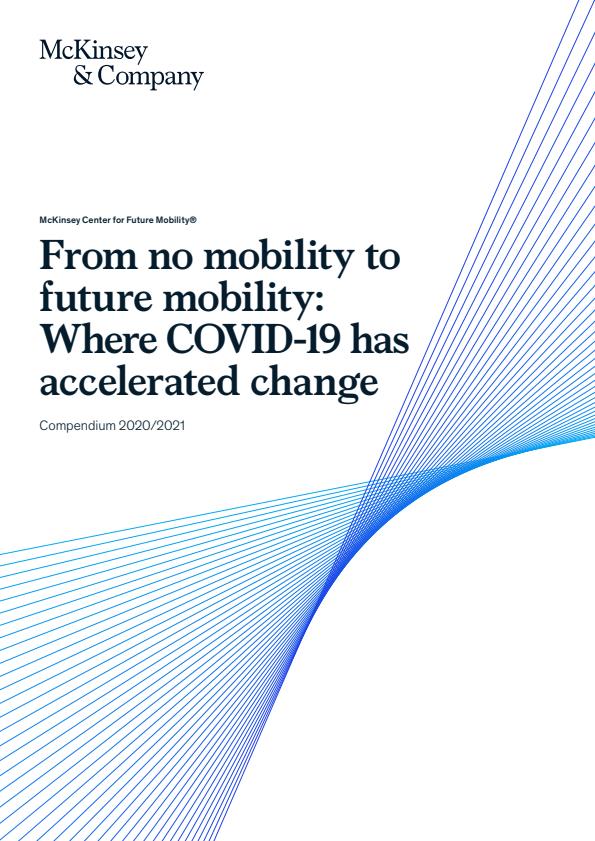COVID-19 swept across the globe in a matter of months, jeopardizing lives, upending businesses, and setting off a worldwide economic slump. Consumers are intensely focused on health and have altered many long-standing habits and preferences to avoid infection. Within the mobility sector, this means that many passengers favor transport modes perceived as safer and more hygienic. Suddenly, private cars are in and shared rides seem to be out. Working from home is on the rise, again with the goal of preserving safety, while business travel and all the mobility services attached to it—flying, taxis, e-hailing—are in low demand. The best-laid plans of mobility players appear to be in tatters. It may seem that the acceleration of future mobility has come to a halt, but this first impression overlooks recent developments that will have a tremendous impact on mobility’s future.
Consider some recent developments: cities have redefined car lanes to create more space for bikes and scooters as people began to avoid public transportation. Similarly, government incentives to help the automotive industry have encouraged the use of carbon-neutral solutions and stimulated the development of electric vehicles (EVs). In another shift arising from the pandemic, consumers are increasingly turning to digital channels—from convenient food deliveries to streaming services—and they now expect mobility players to expand their online offerings.
Such fundamental changes, along with other recent developments, are prompting mobility leaders to reimagine the future of mobility. They had already been adjusting their strategies to the emergence of ACES—autonomous driving, connected cars, electrified vehicles, and shared mobility—and now they are going even further to account for the pandemic’s impact on consumer behavior, policy making, and regional economies. The following shifts are likely to persist long after COVID-19 is controlled and thus deserve particular attention:
- Customer preferences. In addition to safety, consumers are becoming more focused on digital channels and sustainability issues. Access to micromobility options—lightweight vehicles such as bicycles, e-scooters, and mopeds—will be important, as will safety and health issues.
- Technology. The pace of change will continue to accelerate in all areas, including connectivity, autonomous driving, and urban transport.
- Regulations. We expect regulators to become even more active within the mobility sphere. Many, for instance, are tightening CO2 regulations for vehicles as they attempt to reduce climate change.
Exhibit 1 summarizes some of the most important shifts in these areas.

The articles in our compendium explore the major developments within mobility in 2020 and also look ahead to 2021, as approved vaccines will, it is to be hoped, limit the spread of COVID-19 and usher in the next normal. Here are a few of the topics we will explore.
Consumer preferences
Many car dealerships closed in 2020, and car buying plummeted, especially early in the year. In February, sales were down 71 percent in China; in April, they decreased by 80 percent in Europe and 47 percent in the United States. Likewise, mobility behavior changed drastically during the pandemic, as many commuters worked from home and others avoided public transportation because of health concerns. While consumers have traditionally focused on time to destination, cost, and convenience when selecting a transport mode, they now cite the ability to reduce the risk of infection as their major consideration (Exhibit 2).

In a related trend, transport modes that are considered safe have become more popular. With consumers focused on avoiding infection, mobility service providers quickly implemented a range of safety improvements (Exhibit 3). These changes will persist, and providers may soon add other safety measures that span the entire customer journey. Changing consumer preferences may give private-car use the greatest boost, but micromobility options and walking/biking are also expected to gain ground.

Consumer preferences related to ACES
The articles in our compendium also examine how customers perceive ACES developments. In a recent survey, which examined consumer mobility preferences worldwide, we found that customers believe traditional automakers are well qualified to drive ACES innovation. That finding marks a big departure from previous surveys, in which consumers stated that established OEMs lagged behind their Asian counterparts and start-ups in pursuing ACES trends.
Some of the greatest changes in consumer preferences relate to EVs. Insights from our EV consumer survey show that consideration of EVs has increased by an average of about 21 percent over the last three years, partly because buyers are now more aware of their benefits. Still, consumers have significant concerns about EVs, such as those regarding battery/charging, driving range, and higher costs compared with ICE (internal combustion engine) vehicles. These issues may explain why relatively few consumers move from EV consideration to purchase.
EV sales are not destined to remain low, however. As automakers recognize the growing interest in EVs, many have begun revising their go-to-market (GTM) models for this segment. A seven-step approach may help to increase their sales significantly (Exhibit 4).

The growing importance of online channels
In addition to exploring new products and mobility options, consumers are interested in new services. This shift is clearly apparent in automotive retailing, where a future beyond bricks and mortar is emerging. Although consumers still rank dealership visits as the top factor influencing purchase decisions, digital channels are becoming more important. In a recent survey, more than 80 percent of respondents used online channels during the purchase-consideration period, and more than 60 percent said it would be appealing or very appealing to have digital channels for booking, paying, and reviewing additional services (Exhibit 5).

New attitudes about auto financing and vehicle ownership
Consumers are now open to financing their vehicles through digital channels: a survey of auto-financing executives showed that respondents expect online business-to-consumer sales for auto loans and leasing to reach a market share of approximately 20 to 25 percent by 2025 (Exhibit 6).

The same survey suggested that more consumers may be open to forgoing car ownership in favor of vehicle-subscription services. While such subscriptions are still niche products, they show strong promise. Demand may be particularly strong for fully flexible products, such as leasing models with nonbinding durations.
Technology
Although many mobility players focused on responding to COVID-19 in 2020, they continued to invest in ACES. Funding such innovations has always been challenging given the high costs, and the pandemic has exacerbated this issue because traditional OEMs have undertaken cash-preserving measures and cost-cutting initiatives that leave little room for technology investments.
OEMs and suppliers may mitigate some funding issues by undertaking partnerships with other companies. Even before COVID-19 hit, many companies were investing in these ventures, with the number of ACES partnerships increasing 40-fold over the past decade (Exhibit 7). With COVID-19 putting budgets under pressure at OEMs and suppliers, these partnerships will become even more essential.

Electric vehicles
Technology advancements are arguably most apparent within electric mobility. As an article in our compendium explains, the automotive industry will introduce about 600 new battery-electric vehicles (BEVs) and plugin-hybrid EVs through 2025, increasing customer choice significantly. Over that same time frame, OEMs will devote more than $120 billion in capital expenditures to BEVs—about 25 to 30 percent of the total (Exhibit 8).

Europe and China are currently in the lead with EVs, as measured by our yearly McKinsey Electric Vehicle Index. The European market grew 44 percent between 2018 and 2019, even as growth slowed in many other countries. China saw slower growth than Europe during this period, but it remains the largest EV market. There are many established Chinese players and new entrants, all of which compete fiercely at the local and global levels. Our benchmark of ten leading Chinese BEV models shows the dominance of local companies. These players account for 85 percent of BEV sales within China and 57 percent globally.
Automotive electronics and software
The role of automotive electronics and software continues to become more important, with both markets expected to see strong growth (Exhibit 9). Components that will be in strong demand include electronic control units (ECUs) and domain control units, which will account for an estimated $156 billion in annual sales in 2030. Software—functions, operating systems, middleware—will account for $50 billion in annual sales.

Automotive cybersecurity
At many OEMs, cybersecurity has become a top concern. Currently, only narrow standards and guidelines exist for specific technical procedures for securing hardware and software in vehicles, such as standards for hardware encryption or secure communication among ECUs. That will soon change, however. The World Forum for Harmonization of Vehicle Regulations (WP.29), under the UN Economic Commission for Europe, is planning to release new regulations on cybersecurity and over-the-air software updates. The cybersecurity market is expected to have a compound annual growth rate of 7 percent through 2030, when it will reach $9.7 billion in value (Exhibit 10).

Other technology developments
Many other technology developments are altering the mobility landscape, and innovation will continue to have a profound impact in 2021. Recent advances and potential future developments that our compendium explores include the following:
- With software and high tech becoming more important to vehicles, automakers are increasingly looking for new pools of talent and an innovative R&D model.
- 5G technology, with its superior speed, latency, reliability, and power consumption for handsets and Internet of Things (IoT) devices, has recently become mainstream in many sectors, and there are interesting use cases related to mobility.
- Quantum computing could assist with many steps across the automotive value chain as suppliers, OEMs, dealerships, and others take advantage of its power.
- Urban air mobility is becoming more cost-competitive and could offer new mobility options, provided that sufficient pilots are available.
Would you like to learn more about the McKinsey Center for Future Mobility?
Regulation
The automotive and mobility industries have always been tightly regulated, but governments around the globe are now playing an ever bigger role by instituting travel restrictions and other guidelines to limit the spread of COVID-19. Even after the pandemic abates, we expect that policy makers will increasingly shape mobility’s future through new guidelines and regulations.
New guidelines to limit emissions
To encourage car sales and stimulate the economy, some governments have created policies favoring low-emission vehicles and alternative forms of transportation. The new regulations can vary greatly by region, however. In Germany, for example, purchase-price subsidies for new EVs can amount to more than $10,000 per vehicle. In China, the purchase-price subsidy currently ranges from 16,200 to 22,500 renminbi (approximately $2,350 to $3,265) per car, depending on its range.
The regulatory variations, combined with macroeconomic changes, infrastructure, and other factors, will influence how quickly the EV market recovers in different countries (Exhibit 11). The EV market is much more likely to see a quick recovery and strong growth in China and Europe than in the United States, where the government is not providing EV subsidies. Over the long term, EV market share is also more likely to increase in China and Europe.

In addition to EV subsidies, some governments provide financial assistance to encourage the use of low-carbon transportation alternatives. The Italian government offers its citizens a €500 bonus for buying a bike, and the policy has been so successful that many bicycle shops are out of stock.
Impact of regulations on infrastructure
Government planners are constantly making mobility decisions, since they must design car lanes, pedestrian walkways, EV-charging infrastructure, and much more. Since the pandemic, city leaders have been especially active in making infrastructure changes that affect mobility. Consider a few recent examples:
- Milan announced it will transform 35 km (about 22 miles) of streets previously used by cars to walking and cycling lanes.
- Paris will devote 50 km (30 miles) of lanes usually reserved for cars to bicycles; it also plans to invest $325 million to update its bicycle network.
- Seattle permanently closed 30 km (20 miles) of streets to most vehicles at the end of May 2020, providing more space for people to walk and bike after the lockdown.
- Berlin repurposed some residential streets as “play streets” on Sundays during the lockdown and is also discussing the possibility of extending the program to other days of the week.
The outlook for 2021 and beyond
Certainly, no one could have imagined how the world would change in 2020. Next year will also bring much uncertainty, but one thing is definite: mobility will continue to evolve in exciting ways. Here are the major developments we expect:
Expanded consumer preferences and a greater focus on sustainability
When the COVID-19 pandemic is controlled—it’s to be hoped at some point in 2021—consumers will be more willing to use public transport and other forms of shared mobility. We expect that sustainability will continue to be an important consideration, with more consumers opting for electric and micromobility solutions, especially in cities. Car sales may continue to decline from their 2019 peak, as more consumers consider alternatives to car ownership.
Continued technology disruptions and widely available innovations
Automotive technology will continue to evolve in 2021, and consumers will have greater access to innovations. For instance, 60 percent of premium OEMs plan to have some form of level 4 automation in their vehicles by 2025. Vehicle electrification will also continue, and innovations could drive EV costs down even further. (The total cost of ownership for BEVs has already reached parity with ICE vehicles in the C-segment.) For technology overall, we expect that software will increasingly become the key differentiator for vehicles.

The future of micromobility: Ridership and revenue after a crisis
Regulation will continue to enable the mobility revolution
Continuing the trend seen in 2020, many regulators will focus on environmental issues when enacting mobility guidelines. For instance, European officials are planning to create more stringent carbon-reduction targets to meet the Paris Agreement on climate change. Many governments are also creating new incentives to boost the sales of carbon-free means of transport, and others are issuing guidelines with similar goals. Already, more than 150 cities in Europe restrict access to their centers to reduce pollution and carbon emissions.
Long-term mobility shifts
Over the next decade, the changes in consumer preferences, technology, and regulations will contribute to major mobility shifts (Exhibit 12). Regional variations will continue to be apparent because of differences in government responses, the intensity of the pandemic, and other factors. For instance, private-car use may drastically decrease in some major European cities. In North America, by contrast, this form of transport will see little change because there are limited incentives to change mobility behavior. Likewise, consumers in greater China may increasingly rely on public transit and rail, but major cities in South Asia will see little change in this area.

Comparing large global cities highlights significant differences in expected regional mode-share shifts through 2030.
| North America - Car-reliant major cities | Europe - Western metropolitan areas | East Asia4 - Metropolitan areas | South America - Southern Cone cities | Greater China5 - Tier-1 cities | South Asia - Metropolitan areas | |||||||
|---|---|---|---|---|---|---|---|---|---|---|---|---|
| 2019 | 2030 | 2019 | 2030 | 2019 | 2030 | 2019 | 2030 | 2019 | 2030 | 2019 | 2030 | |
| Private vehicles | 92.1 | 88.4 | 45.3 | 10.3 | 35.3 | 22.5 | 31.3 | 16.8 | 29.9 | 13.1 | 3.3 | 0.7 |
| Taxi or e-hailing | 1.6 | 1.6 | 5.1 | 3.3 | 3 | 3.5 | 0.9 | 1.6 | 6.1 | 5.8 | 0.9 | 0.3 |
| New modes2 | 0 | 6.1 | 0 | 33.6 | 0 | 5.1 | 0 | 3.7 | 0 | 7 | 0 | 0.4 |
| Public transit (bus) | 3.9 | 1.4 | 16.8 | 13.1 | 10.8 | 10.1 | 33 | 39.3 | 22.2 | 22.2 | 10.3 | 12.1 |
| Public transit (rail) | 0.7 | 0.5 | 19.6 | 22.4 | 42.1 | 46.7 | 21.5 | 22.7 | 34.6 | 39.7 | 79.9 | 80 |
| Shared micromobility | 0.2 | 1 | 0.2 | 2.8 | 0.2 | 3.7 | 0.2 | 4.7 | 1.6 | 6.6 | 0.9 | 3.7 |
| Other3 | 1.5 | 1 | 13 | 14.5 | 8.6 | 8.4 | 13.1 | 11.2 | 5.6 | 5.6 | 4.7 | 2.8 |
| Sample drivers |
Car-based infrastructure limits disruptions AVs6 disrupt transit usage in city centers |
Street redesigns cut congestion and car usage |
Reliable, high-quality transit withstands disruption Shared AVs are widely available but sparingly used |
AV shuttles penetrate taxi/bus networks Cycle paths and regulations limiting cars reduce congestion |
Public transit gets large investments Robotaxis see limited use because of lower-income residents |
AVs struggle to operate in chaotic streets Crowded rail networks are most used | ||||||
Notes
1Policy-guided shift to pooled autonomous-vehicle and transit scenario.
2New modes include roboshuttles, as well as pooled and unpooled robotaxis.
3"Other" includes walking, biking, private micromobility, 2- and 3-wheelers.
4Utilizes Japan city archetype for Tokyo.
5Greater China encompasses mainland China, Hong Kong, Macau, and Taiwan.
6Autonomous vehicles.
Source: McKinsey Center for Future Mobility
McKinsey & Company
Implications for mobility players
The novel coronavirus has forced many businesses, including those in the mobility sector, to cease or slow down operations. It has also accelerated many existing mobility trends, including those related to customer preferences and regulation. As our compendium shows, all mobility players, including OEMs, new entrants, investors, and regulators, must quickly adjust their strategies to navigate the current crisis and prepare for the next normal.
For automotive OEMs and suppliers, surviving and emerging stronger at the far end of this crisis will require thinking beyond the next fiscal quarter. Success in the long run will require a journey across five stages: resolve, resilience, return, reimagination, and reform.
Despite the pandemic, many companies have continued to invest in disruptive mobility technologies, including autonomous technology, connectivity, EVs, and other areas. These businesses have the support of capital markets, and many special-purpose acquisition companies have recently made some successful deals. In 2021, disruptors will exert their presence more strongly. While they may compete with traditional companies in some areas, they will cooperate with them in others.
Regulators will continue to play a major role in helping the mobility sector recover from the pandemic. Many mobility solutions will have an intense local focus and take into account regional variations related to the pandemic, transportation preferences, and city layouts. In addition to creating mobility systems that serve the greater good, regulators will help ensure sustainability. Of course, they must continue to consider technological feasibility while trying to satisfy customer preferences.



